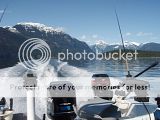Redundancy is a good thing!
With twins you should have “at least” two batteries, each dedicated to each engine. One engine - charging one battery, if you have 2 engines charging one battery you do run the risk of “over charging” a battery and/or batteries, not a good thing and that can easily be done with twins! I have three batteries, one battery for the port engine, one for starboard. The third battery is tied to my starboard, which is the “bank” used for the house. The batteries feed to a “main” buss, which controls everything; including my downriggers and all electronics. I have a battery switch for both and can charge either and all batteries, so I can run that main buss from either engine if needed.
When I unplug from shore power and go fishing for a day, or so - I have never had any issues, but as much fishing I do offshore (without shore power) I all ready know I am going to run my house bank down. That is a fact, the only question is how fast and when, and that is based on what I am running. There have been a lot of times (with no shore power) and when trolling, I have switched to “both” to have both engines charging my #2 starboard bank, but you need to be careful doing that, not to overcharge the battery and/or batteries.
 ]
]



